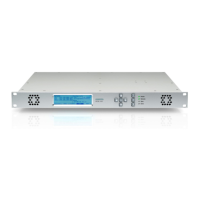RCS User Manual
17
SNMP: The RCS system incorporates a SNMP agent to send traps of the generated alarms to a
server selected by the user. A SNMP client must be running in the server to receive the traps from
the RCS. The IP server can be entered on the "Trap IP Address" field. It is also necessary to
indicate the “Trap Community” and “RW Community”. The user can also select the type of trap that
the user wants to send:
-Trap: the system sends the trap and doesn’t wait for confirmation.
-Inform: the system sends the trap, but it waits for the receiver to confirm that it has received
the report. In this case, the user must select the number of retries and the time interval
between them.
The mib (Management Information Base) file can be downloaded by clicking on the “Download mib”
button. In this way, the user can check the data structure and the features with explanatory
comments to obtain the data from the RCS trough SNMP.
Please check Annex 1.- Introduction to SNMP for more details.
IGMP: The IGMP protocol can be set in agreement with the network configuration, allowing to select
the protocol version (Auto, V1, V2 or V3). To apply the configuration, click on the “Apply settings”
button.
QoS Settings: Allows to set all the parameters needed to give an objective measure of the quality
of the service. The user has to configure three parameters for each group of measures (SAE+SAE
ratio / SDE+SDE ratio / SIE+SIE ratio). Those parameters are:
Time: It is the difference of time that the RCS uses to compare the errors indicated in the flags
parameter.
Window: It is the period of time over which the corresponding QoS measure is displayed.
Flags: The user has to select the errors to consider to obtain the corresponding QoS measurement.
Following you can see the method to obtain the SAE measurement (the SDE and the SIE
measurements are calculated in the same way:
Count the occurrence of error messages for the following parameters over a Time interval:
TS_sync_loss, PAT_error, and PMT_error (if all the Flags are selected).
For each Time interval, the following differences are calculated:
TS_sync_loss(Time) = TS_sync_loss(T) - TS_sync_loss(T-Time)
PAT_error(Time) = PAT_error(T) - PAT_error(T-Time)
PMT_error(Time) = PMT_error(T) - PMT_error(T-Time)
The Service Avaiability Error is the maximum of TS_sync_loss(Time), PAT_error(Time), and
PMT_error(Time). And the results over a Window period of time are displayed.
The Service Avaiability Error Ratio is the percentage of time for wich the parameter exceeds the
user-defined threshold.
Black and Freeze Settings: Allows to set the parameters needed to detect the black and freeze
events (only for RCS100 and RCS400 with the option 902568). These parameters are:

